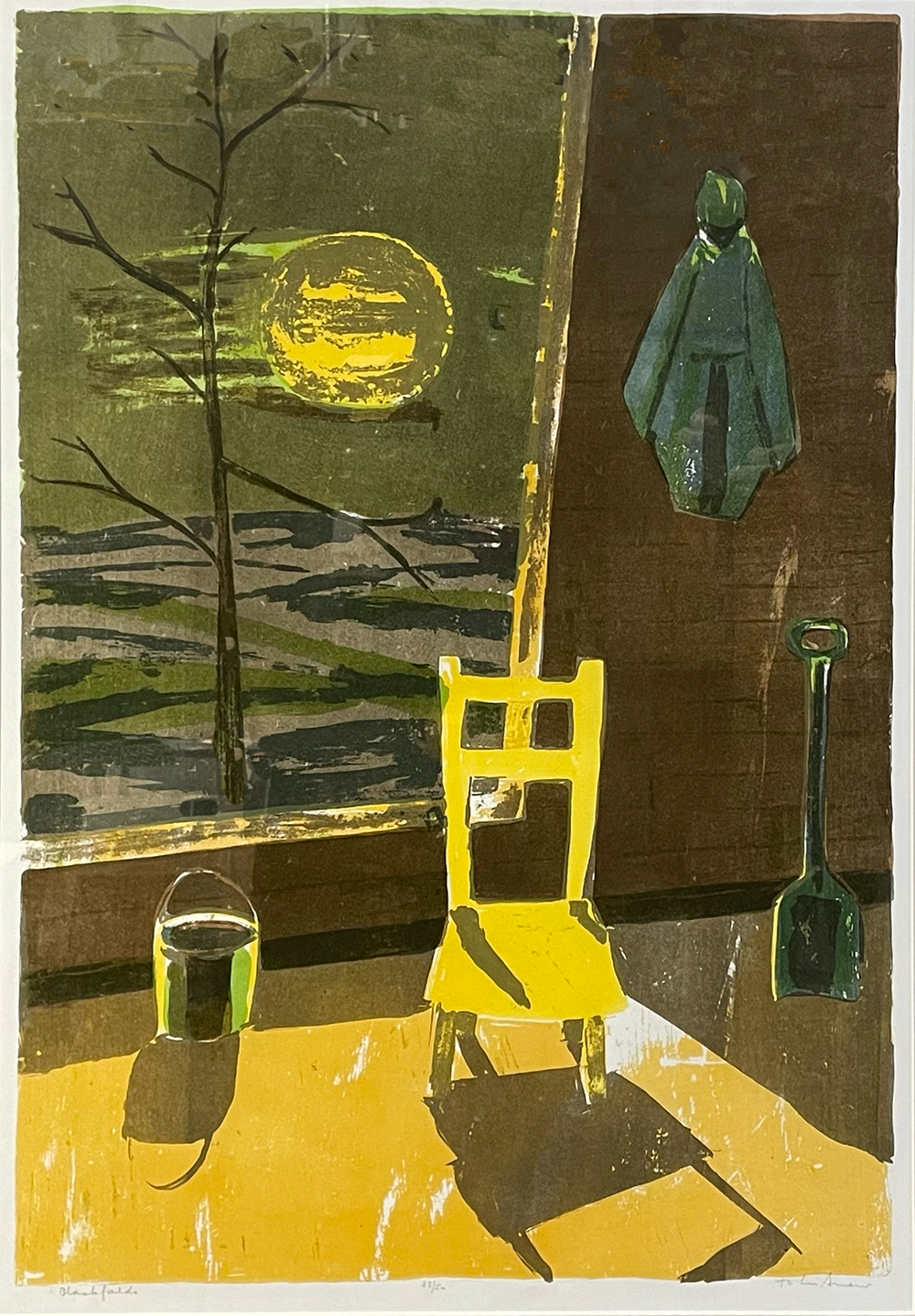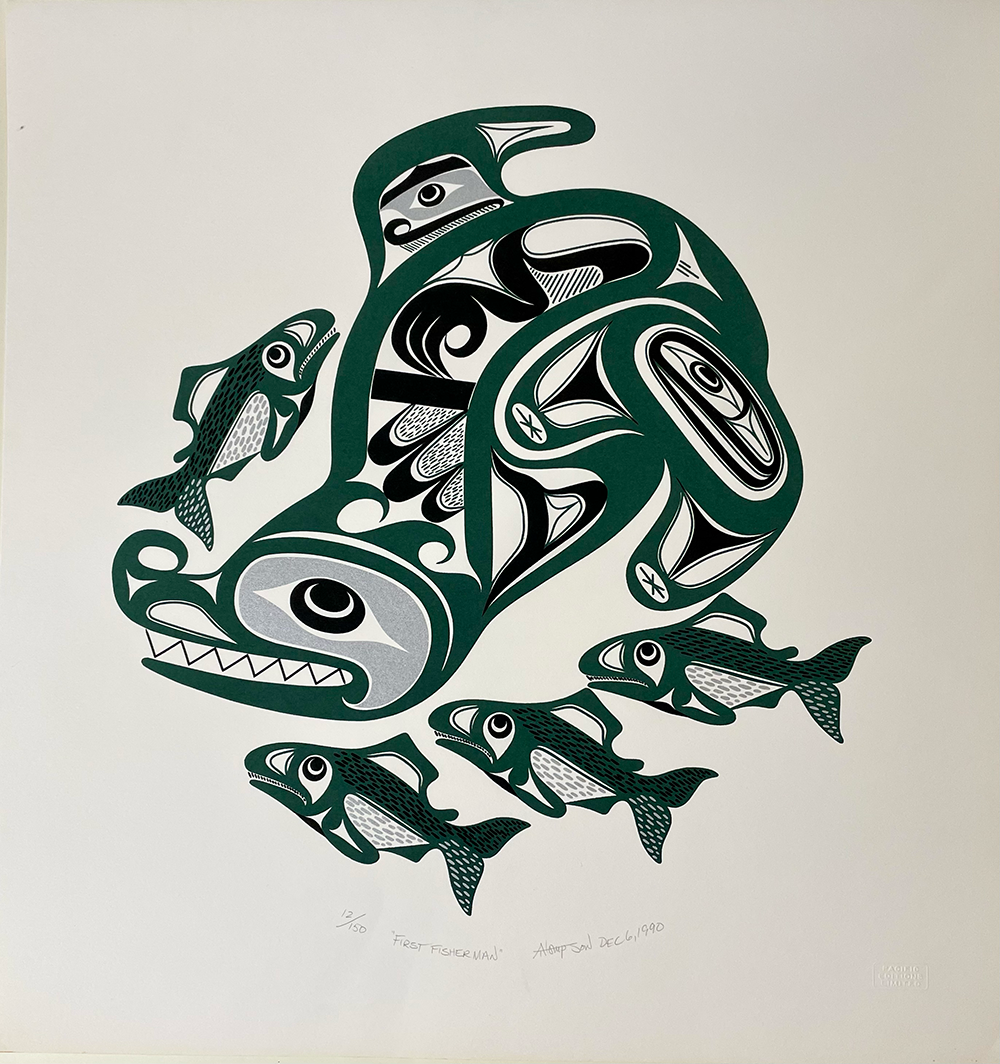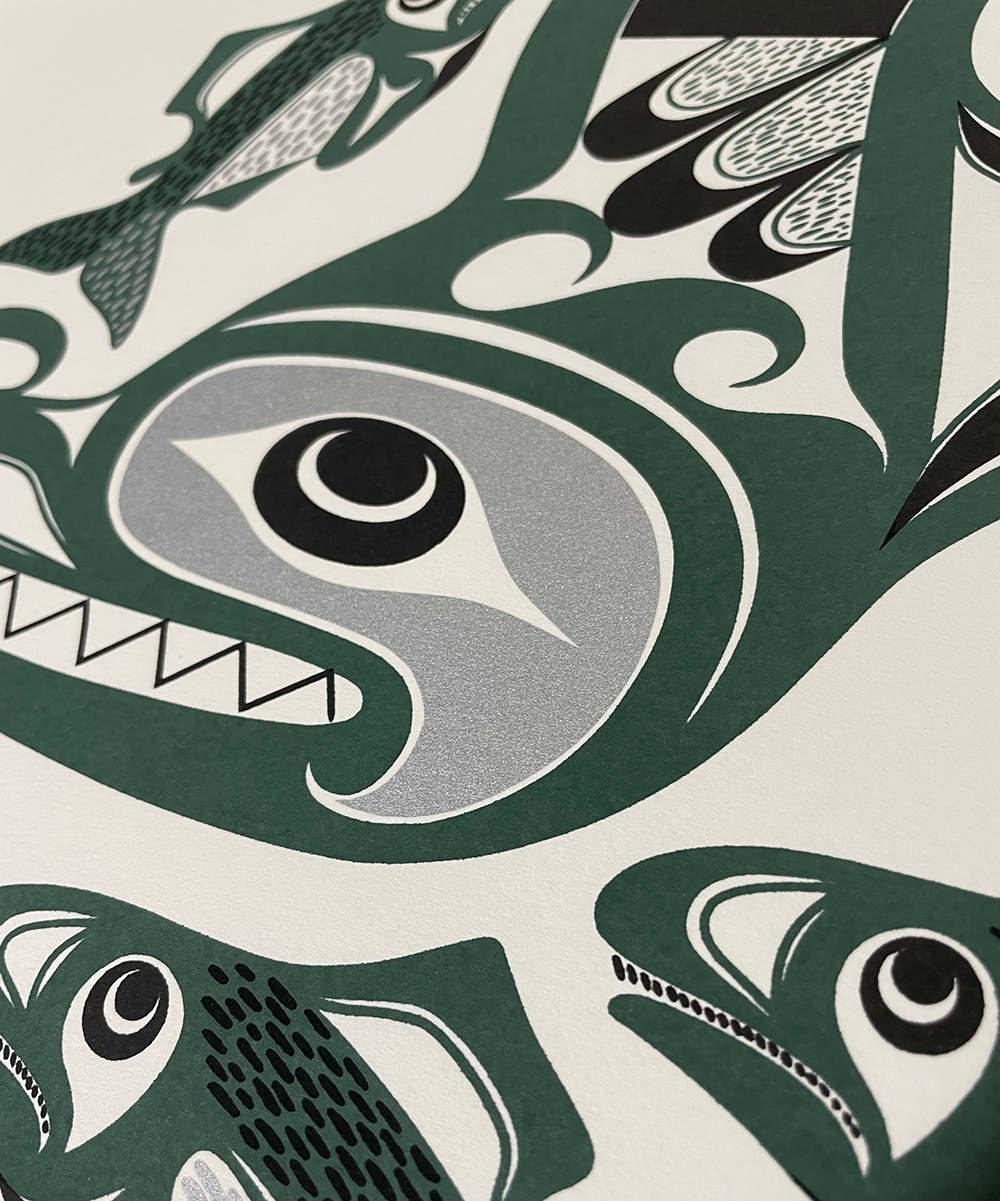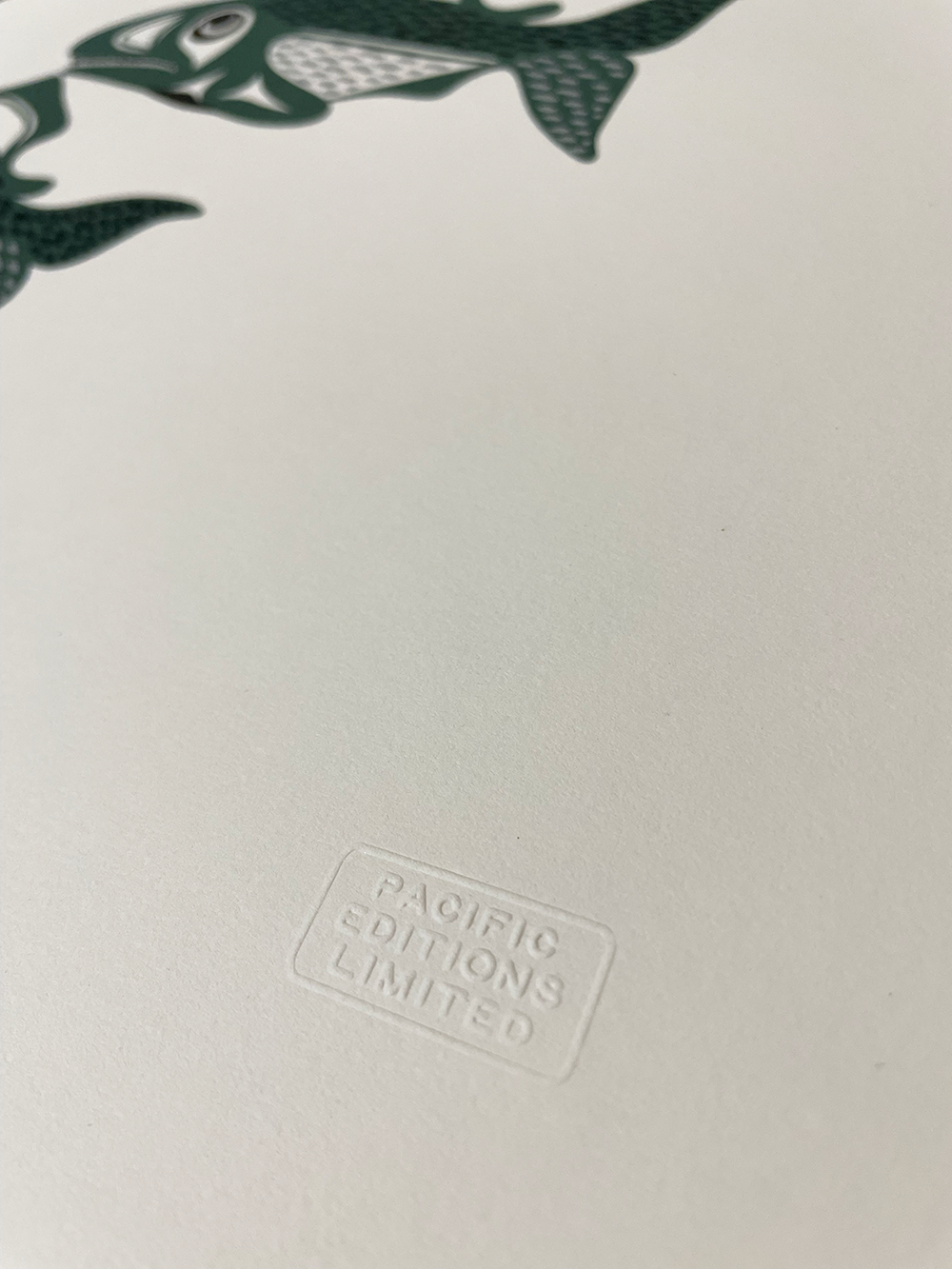 Image 1 of 3
Image 1 of 3

 Image 2 of 3
Image 2 of 3

 Image 3 of 3
Image 3 of 3




John Snow, Blackfalds, stonecut print 33/50
Stonecut lithograph print by John Snow, signed and numbered 33/50, titled “Blackfalds”. (Blackfalds is a small town in central Alberta, Canada.)
Framed 35” x 26” with visible image 27” x 18.5” in a deep green bevel moulding.
Please note: There is a small chip in the bottom right hand corner of the frame.
Please contact us if you require shipping. We use Canada Post. Personal delivery is also available for a flat rate of $40 plus GST to the Okanagan and Lower Mainland during our scheduled trips.
John Snow, 1911 - 2004
John Harold Thomas Snow was born in Vancouver in 1911. His family moved to England during WWI, there, Snow’s English relatives fostered in him an interest in art and music. The family returned to Olds, Alberta in 1919.
In 1928, Snow took a job with the Royal Bank of Canada and began a distinguished banking career that would last 43 years. His career was only interrupted when he was called to service in WWII as a navigator in the Royal Canadian Air Force.
When the war ended, Snow returned home with a renewed interest in art. He signed up for a life drawing class with Maxwell Bates at the Provincial Institute of Technology. Bates and Snow became good friends and in 1953, they famously “rescued” two old lithographic presses with an old truck from the alley behind the Western Printing and Lithograph Company.
Bates and Snow had no idea how to run the press, but by trial and error and reading books they mastered the machine. Soon both were creating artworks using the press. However, this lithography press would define Snow’s work for the rest of his life. He produced 410 of his own lithographs, plus assisted fellow artists. such as Bates, Illingworth Kerr and Pat Gordon with editions of their lithographs. Snow was deemed a mentor to new artists and helped usher Alberta into the modernist period along with Max Bates.
Besides his career in visual art, Snow organized the Calgary Film Society in the late 1940s and served as its president. Also an accomplished musician, Snow was instrumental in creating the New Works Calgary Society, which is dedicated to presenting new compositions, many commissioned by the society.
Snow retired from the Royal Bank 1971, his works are still proudly displayed in the bank's head office in Montreal. Snow produced numerous exhibitions throughout Canada, the U.S., Japan, France, England, Chile, Mexico, Italy, Scotland, and Australia.
He received the Alberta Order of Excellence on November 21, 1996.
John Snow died peacefully on August 23, 2004 at the age of 92, after several years of failing health.
Selected Collections
Alberta's Government House in Edmonton, AB
City of Calgary, AB
Grant MacEwan Community College in Edmonton, AB
National Gallery of Canada, Ottawa, ON
Residence of the Governor General of Canada, Ottawa, ON
Royal Canadian Academy of the Arts, Toronto, ON
Royal Bank, Head office, Montreal, QB
Parks Canada, Gatineau, QB
Lithography is a printing process that uses a flat stone or metal plate on which the image areas are worked using a greasy substance so that the ink will adhere to them by, while the non-image areas are made ink-repellent.
Lithography comes from the combination of two Greek words: ‘lithos’ which means stones and ‘graphein’ meaning to write. The method of lithography was invented in 1798 by a German playwright and author named Aloys Senefelder who was seeking to develop a new method of publishing many copies of his plays in a short amount of time.
Lithography involves the manipulation of oil-based materials and water to create an inked impression onto paper. Artists first draw the image they intend to print onto a polished limestone slab using an oil-based crayon or ink material. Modern artists are able to produce lithographs using metal plates that consist of zinc or aluminum.
After the drawing is finished, the artist coats the stone with a powdered rosin material, as well as talc. The artist then wipes a layer of gum arabic over the stone which is able to bond the oil-based ink or crayon onto the stone. This gum arabic material will allow the stone to repel ink in blank spaces while the coloured portion holds the substance and is able to leave an impression.
The artist will then wipe away the image using a solvent called lithotine before applying a layer of asphaltum to the stone surface which is allowed to dry. The stone is now ready to be used for printing after it is dampened with water. An artist will apply ink using a roller as the stone now repels the ink in areas where the image is blank or void of colour. A simple press is used to apply the ink held in the stone to a sheet of paper, leaving a perfect duplicate of the image the artist had originally drawn.
Artists can create coloured lithograph images by using multiple stones which the artist draws each desired colour on. The alignment of each image is crucial in creating an accurate image. One single stone can be used for many years to duplicate a single image and create many prints of a specific work of art. Machines are used to create what is known as ‘offset lithographs.’
Stonecut lithograph print by John Snow, signed and numbered 33/50, titled “Blackfalds”. (Blackfalds is a small town in central Alberta, Canada.)
Framed 35” x 26” with visible image 27” x 18.5” in a deep green bevel moulding.
Please note: There is a small chip in the bottom right hand corner of the frame.
Please contact us if you require shipping. We use Canada Post. Personal delivery is also available for a flat rate of $40 plus GST to the Okanagan and Lower Mainland during our scheduled trips.
John Snow, 1911 - 2004
John Harold Thomas Snow was born in Vancouver in 1911. His family moved to England during WWI, there, Snow’s English relatives fostered in him an interest in art and music. The family returned to Olds, Alberta in 1919.
In 1928, Snow took a job with the Royal Bank of Canada and began a distinguished banking career that would last 43 years. His career was only interrupted when he was called to service in WWII as a navigator in the Royal Canadian Air Force.
When the war ended, Snow returned home with a renewed interest in art. He signed up for a life drawing class with Maxwell Bates at the Provincial Institute of Technology. Bates and Snow became good friends and in 1953, they famously “rescued” two old lithographic presses with an old truck from the alley behind the Western Printing and Lithograph Company.
Bates and Snow had no idea how to run the press, but by trial and error and reading books they mastered the machine. Soon both were creating artworks using the press. However, this lithography press would define Snow’s work for the rest of his life. He produced 410 of his own lithographs, plus assisted fellow artists. such as Bates, Illingworth Kerr and Pat Gordon with editions of their lithographs. Snow was deemed a mentor to new artists and helped usher Alberta into the modernist period along with Max Bates.
Besides his career in visual art, Snow organized the Calgary Film Society in the late 1940s and served as its president. Also an accomplished musician, Snow was instrumental in creating the New Works Calgary Society, which is dedicated to presenting new compositions, many commissioned by the society.
Snow retired from the Royal Bank 1971, his works are still proudly displayed in the bank's head office in Montreal. Snow produced numerous exhibitions throughout Canada, the U.S., Japan, France, England, Chile, Mexico, Italy, Scotland, and Australia.
He received the Alberta Order of Excellence on November 21, 1996.
John Snow died peacefully on August 23, 2004 at the age of 92, after several years of failing health.
Selected Collections
Alberta's Government House in Edmonton, AB
City of Calgary, AB
Grant MacEwan Community College in Edmonton, AB
National Gallery of Canada, Ottawa, ON
Residence of the Governor General of Canada, Ottawa, ON
Royal Canadian Academy of the Arts, Toronto, ON
Royal Bank, Head office, Montreal, QB
Parks Canada, Gatineau, QB
Lithography is a printing process that uses a flat stone or metal plate on which the image areas are worked using a greasy substance so that the ink will adhere to them by, while the non-image areas are made ink-repellent.
Lithography comes from the combination of two Greek words: ‘lithos’ which means stones and ‘graphein’ meaning to write. The method of lithography was invented in 1798 by a German playwright and author named Aloys Senefelder who was seeking to develop a new method of publishing many copies of his plays in a short amount of time.
Lithography involves the manipulation of oil-based materials and water to create an inked impression onto paper. Artists first draw the image they intend to print onto a polished limestone slab using an oil-based crayon or ink material. Modern artists are able to produce lithographs using metal plates that consist of zinc or aluminum.
After the drawing is finished, the artist coats the stone with a powdered rosin material, as well as talc. The artist then wipes a layer of gum arabic over the stone which is able to bond the oil-based ink or crayon onto the stone. This gum arabic material will allow the stone to repel ink in blank spaces while the coloured portion holds the substance and is able to leave an impression.
The artist will then wipe away the image using a solvent called lithotine before applying a layer of asphaltum to the stone surface which is allowed to dry. The stone is now ready to be used for printing after it is dampened with water. An artist will apply ink using a roller as the stone now repels the ink in areas where the image is blank or void of colour. A simple press is used to apply the ink held in the stone to a sheet of paper, leaving a perfect duplicate of the image the artist had originally drawn.
Artists can create coloured lithograph images by using multiple stones which the artist draws each desired colour on. The alignment of each image is crucial in creating an accurate image. One single stone can be used for many years to duplicate a single image and create many prints of a specific work of art. Machines are used to create what is known as ‘offset lithographs.’
Stonecut lithograph print by John Snow, signed and numbered 33/50, titled “Blackfalds”. (Blackfalds is a small town in central Alberta, Canada.)
Framed 35” x 26” with visible image 27” x 18.5” in a deep green bevel moulding.
Please note: There is a small chip in the bottom right hand corner of the frame.
Please contact us if you require shipping. We use Canada Post. Personal delivery is also available for a flat rate of $40 plus GST to the Okanagan and Lower Mainland during our scheduled trips.
John Snow, 1911 - 2004
John Harold Thomas Snow was born in Vancouver in 1911. His family moved to England during WWI, there, Snow’s English relatives fostered in him an interest in art and music. The family returned to Olds, Alberta in 1919.
In 1928, Snow took a job with the Royal Bank of Canada and began a distinguished banking career that would last 43 years. His career was only interrupted when he was called to service in WWII as a navigator in the Royal Canadian Air Force.
When the war ended, Snow returned home with a renewed interest in art. He signed up for a life drawing class with Maxwell Bates at the Provincial Institute of Technology. Bates and Snow became good friends and in 1953, they famously “rescued” two old lithographic presses with an old truck from the alley behind the Western Printing and Lithograph Company.
Bates and Snow had no idea how to run the press, but by trial and error and reading books they mastered the machine. Soon both were creating artworks using the press. However, this lithography press would define Snow’s work for the rest of his life. He produced 410 of his own lithographs, plus assisted fellow artists. such as Bates, Illingworth Kerr and Pat Gordon with editions of their lithographs. Snow was deemed a mentor to new artists and helped usher Alberta into the modernist period along with Max Bates.
Besides his career in visual art, Snow organized the Calgary Film Society in the late 1940s and served as its president. Also an accomplished musician, Snow was instrumental in creating the New Works Calgary Society, which is dedicated to presenting new compositions, many commissioned by the society.
Snow retired from the Royal Bank 1971, his works are still proudly displayed in the bank's head office in Montreal. Snow produced numerous exhibitions throughout Canada, the U.S., Japan, France, England, Chile, Mexico, Italy, Scotland, and Australia.
He received the Alberta Order of Excellence on November 21, 1996.
John Snow died peacefully on August 23, 2004 at the age of 92, after several years of failing health.
Selected Collections
Alberta's Government House in Edmonton, AB
City of Calgary, AB
Grant MacEwan Community College in Edmonton, AB
National Gallery of Canada, Ottawa, ON
Residence of the Governor General of Canada, Ottawa, ON
Royal Canadian Academy of the Arts, Toronto, ON
Royal Bank, Head office, Montreal, QB
Parks Canada, Gatineau, QB
Lithography is a printing process that uses a flat stone or metal plate on which the image areas are worked using a greasy substance so that the ink will adhere to them by, while the non-image areas are made ink-repellent.
Lithography comes from the combination of two Greek words: ‘lithos’ which means stones and ‘graphein’ meaning to write. The method of lithography was invented in 1798 by a German playwright and author named Aloys Senefelder who was seeking to develop a new method of publishing many copies of his plays in a short amount of time.
Lithography involves the manipulation of oil-based materials and water to create an inked impression onto paper. Artists first draw the image they intend to print onto a polished limestone slab using an oil-based crayon or ink material. Modern artists are able to produce lithographs using metal plates that consist of zinc or aluminum.
After the drawing is finished, the artist coats the stone with a powdered rosin material, as well as talc. The artist then wipes a layer of gum arabic over the stone which is able to bond the oil-based ink or crayon onto the stone. This gum arabic material will allow the stone to repel ink in blank spaces while the coloured portion holds the substance and is able to leave an impression.
The artist will then wipe away the image using a solvent called lithotine before applying a layer of asphaltum to the stone surface which is allowed to dry. The stone is now ready to be used for printing after it is dampened with water. An artist will apply ink using a roller as the stone now repels the ink in areas where the image is blank or void of colour. A simple press is used to apply the ink held in the stone to a sheet of paper, leaving a perfect duplicate of the image the artist had originally drawn.
Artists can create coloured lithograph images by using multiple stones which the artist draws each desired colour on. The alignment of each image is crucial in creating an accurate image. One single stone can be used for many years to duplicate a single image and create many prints of a specific work of art. Machines are used to create what is known as ‘offset lithographs.’





















